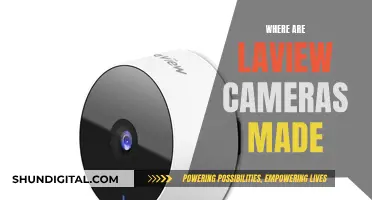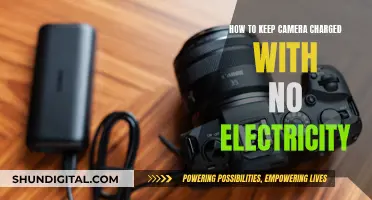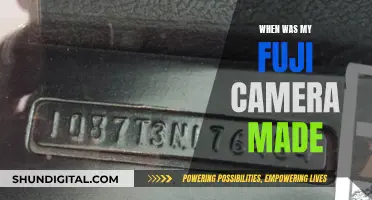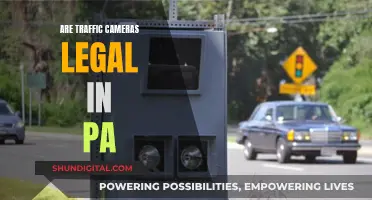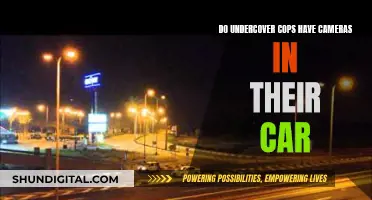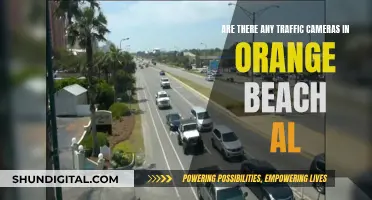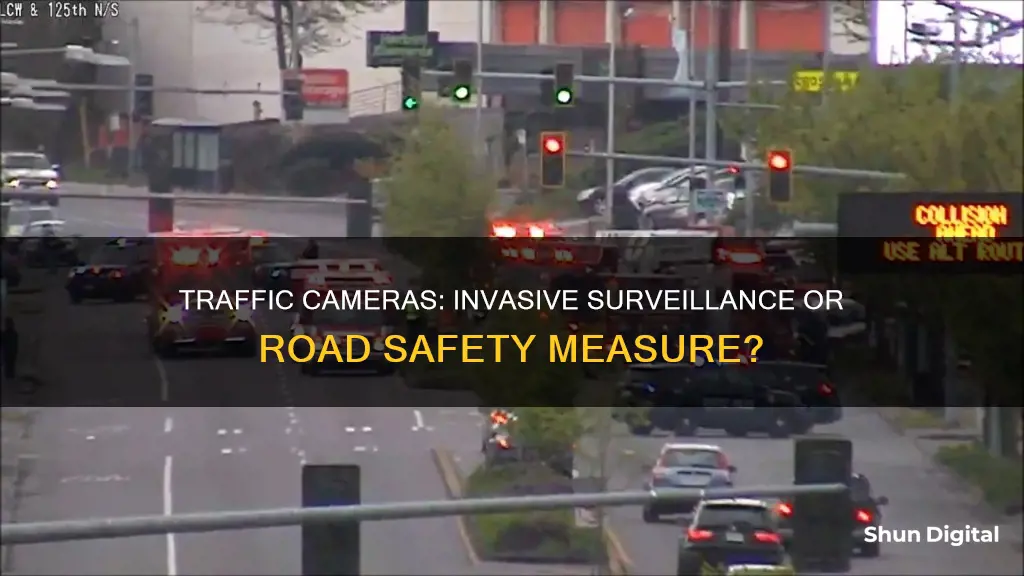
The use of traffic cameras to monitor and enforce road safety has sparked a heated debate in the United States. While some argue that these cameras are an invasion of privacy and a form of entrapment, others maintain that they are necessary for deterring speeding and saving lives. The legality of these measures varies across states, with some like Arizona proposing legislation to ban them, while others like California allow their use with certain restrictions. The key question at the heart of this debate is whether the use of traffic cameras constitutes entrapment, which legally requires proof that law enforcement induced or encouraged a person to commit a crime.
| Characteristics | Values |
|---|---|
| Definition of entrapment | When law enforcement induces a person to commit a crime that they were not predisposed to commit |
| Traffic cameras as entrapment | Traffic cameras are not considered entrapment as they are passive devices that capture a traffic infraction |
| Law enforcement presence | Law enforcement is not required to disclose their presence or location when enforcing speed limits |
| Speed traps | A spot where law enforcement officers lie in wait to catch and ticket drivers exceeding the speed limit |
| Legal status of speed traps | The majority of speed trap methods are legal, even in states with strict speed enforcement laws like California |
| Use of hidden cameras | The use of hidden cameras to enforce speed limits is a different matter and may be considered entrapment |
| Entrapment tactics | Law enforcement cannot use entrapment tactics, such as encouraging motorists to break traffic laws, in order to make arrests |
| Hiding by law enforcement | The act of hiding by law enforcement is not always considered entrapment, but it can be challenged in court |
| Law enforcement on private property | A law enforcement officer hiding on private property must comply if the property owner asks them to leave |
| Validity of tickets | Even if a law enforcement officer is trespassing on private property, any tickets or arrests made will remain valid |
What You'll Learn

Speed cameras are passive devices that capture traffic infractions
Entrapment occurs when law enforcement or someone working with them induces or encourages a person to commit a crime through persuasion, false statements, or other means. Speed cameras are not capable of engaging in such behaviour. They are simply tools used to enforce traffic laws and improve road safety.
In the United States, entrapment is a valid defence in certain extreme cases. However, it is not applicable in most speeding cases. While police might set up a speed trap, this is not considered entrapment. Their conduct does not encourage or induce someone to break the law when they otherwise would not.
Speed cameras are often clearly marked, with signs indicating their presence. This further disproves the notion of entrapment, as motorists are made aware of the potential for enforcement. The use of speed cameras is a contentious issue, with critics arguing that they are unconstitutional and ripe for abuse. However, proponents argue that they save lives and help law enforcement keep streets safe.
While speed cameras may not be well-liked by motorists, their use is generally considered lawful and does not constitute entrapment.
Power Saving Mode: Camera Quality Compromised?
You may want to see also

Traffic cameras do not induce drivers to break the law
The use of traffic cameras to enforce road safety has been a topic of debate. While some people argue that these cameras are a form of entrapment, others believe that they are necessary for maintaining law and order on the roads. Here are some reasons why traffic cameras do not induce drivers to break the law:
Deterring Traffic Violations
Traffic cameras are often installed at intersections and roadsides to capture images or videos of vehicles that break the law. The presence of these cameras can act as a deterrent, encouraging drivers to follow the rules and avoid getting caught. This helps to reduce the number of accidents and creates a safer environment for everyone on the road.
Passive Devices
Traffic cameras are passive devices that do not actively encourage or induce drivers to break the law. They are simply tools used by law enforcement to capture evidence of traffic violations. The decision to speed, run a red light, or break any other traffic law rests solely with the driver and not the camera.
Revenue Generation vs. Road Safety
Critics of traffic cameras often argue that they are nothing more than a revenue-generating scheme for the government. While it is true that fines from traffic violations can generate significant income, the primary purpose of these cameras is to improve road safety and reduce accidents. In fact, many people support the use of traffic cameras because they believe they make the roads safer for everyone.
Respecting Privacy
Some people argue that traffic cameras invade privacy. However, it is important to note that these cameras are typically installed in public places, such as streets, intersections, and government buildings. They capture images and videos of vehicles and their license plates, which are already visible to anyone in the vicinity. Therefore, traffic cameras do not infringe on privacy any more than a passerby or a police officer observing the same scene.
Reducing Police Discretion
Traffic cameras can also help reduce the discretionary power of police officers over motorists. With traditional traffic policing, officers have the authority to pull over drivers, which can sometimes lead to abuse of power or discriminatory practices. Traffic cameras eliminate the need for these stops, as violations are captured on camera and reviewed by officials before any tickets are issued. This reduces the potential for bias or abuse of power by individual officers.
In conclusion, traffic cameras do not induce drivers to break the law. Instead, they serve as a deterrent, encouraging drivers to follow the rules and improve road safety. While there are valid concerns about privacy and government power, the benefits of traffic cameras in reducing accidents and enforcing traffic laws outweigh the potential drawbacks.
Fight Camera Tickets: Know Your Rights and Beat the System
You may want to see also

Traffic cameras are clearly marked by a sign
Traffic cameras are often clearly marked by a sign, but this is not a requirement by law. The presence of a sign is a courtesy extended by the police to caution speeding motorists. The placement of traffic cameras is usually in areas where accidents are more common.
Traffic camera signs are not an indication of the existence of a camera but rather a warning to obey speed limits. The police have the authority to place cameras anywhere and do not need to warn drivers of their presence. The signs are usually placed as a deterrent to speeding.
In some states, the laws require signs to inform drivers that red light cameras are in use at an intersection. These laws specify what the signs must say and where they must be located in relation to the intersection. Drivers cited for violations at intersections without the required signage may have a valid defence against the ticket.
Traffic cameras are not considered entrapment because they are passive devices that capture a traffic infraction. Entrapment applies when law enforcement convinces or encourages an individual to commit an illegal act that they were not otherwise inclined to do.
Understanding Browning Trail Camera's Dark Mode Feature
You may want to see also

Traffic cameras are unconstitutional and ripe for abuse
Traffic cameras are automated camera systems that capture images of vehicles that pass over sensors at intersections or on highways. While these cameras are used to enforce traffic laws and improve road safety, there are concerns about their constitutionality and potential for abuse.
Unconstitutional
The use of traffic cameras has been challenged in several US cities, with critics arguing that they violate the constitutional rights of citizens. One of the main arguments against traffic cameras is the potential violation of the Confrontation Clause, which guarantees the right to confront and cross-examine witnesses. With traffic cameras, the accused may not have the opportunity to question the evidence presented.
Ripe for Abuse
The use of traffic cameras has also been criticised for being "ripe with corruption". In some cases, law enforcement agencies contract out the management of these camera programs to third-party companies, raising concerns about private companies having access to sensitive data and issuing traffic tickets. This privatisation of law enforcement has been criticised as a potential source of fraud and abuse, with some arguing that it infringes on the constitutional rights of citizens.
Lack of Due Process
Another concern with traffic cameras is the lack of due process. With traditional traffic stops, a law enforcement officer directly interacts with the accused and can assess the situation in real time. However, with traffic cameras, the accused may not have the opportunity to explain extenuating circumstances or present their side of the story before receiving a citation.
Encroachment on Privacy
The presence of traffic cameras on public roads and intersections has also raised concerns about privacy. Critics argue that these cameras collect data on motorists, including their location and driving habits, which can be accessed and used by third-party companies. This collection and distribution of personal data without proper oversight or consent can be seen as an invasion of privacy.
Ineffective in Improving Road Safety
While proponents of traffic cameras argue that they improve road safety, studies on their effectiveness have yielded mixed results. While some studies suggest that red-light cameras reduce front-into-side collisions and overall injury crashes, they may also increase rear-end crashes. Additionally, the presence of speed cameras may not always deter speeding and could instead encourage abrupt changes in driving behaviour, potentially creating new safety hazards.
In conclusion, while the use of traffic cameras may have noble intentions, there are valid concerns about their constitutionality and potential for abuse. The privatisation of law enforcement, lack of due process, and encroachment on privacy rights are significant issues that need to be addressed to ensure the fair and ethical use of traffic camera technology.
Finding Your 'S Camera Files' on Your Computer
You may want to see also

Traffic cameras violate the U.S. Constitution's confrontation clause
The Sixth Amendment to the U.S. Constitution, also known as the Confrontation Clause, states that "In all criminal prosecutions, the accused shall enjoy the right ... to be confronted with the witnesses against him ...". This clause grants criminal defendants the ability to face their accusers and cross-examine them, a fundamental aspect of due process rights in the Western legal tradition.
The use of automated photo enforcement, including red-light and speed cameras, has sparked debate over its constitutionality due to the Confrontation Clause. The issue arises because cameras cannot be confronted or cross-examined, and there is no human witness to testify about the circumstances of the alleged violation or the collection, analysis, and transmission of camera "evidence" (photos and videos).
In 2010, the Superior Court of California ruled that camera-based data was inadmissible as evidence because no one with firsthand knowledge of the data's generation or processing was present in court. Similarly, the California Court of Appeal ruled that camera evidence was insufficient to convict a driver without a technician present to testify about the analysis of the evidence. However, conflicting decisions from another panel of the same court upheld camera evidence for conviction, indicating that the Confrontation Clause may not be a definitive defence against camera-based traffic violations.
The U.S. Supreme Court's Melendez decision in 2009 upheld the requirement for third-party technical personnel to explain how certain data was compiled and analysed, supporting the Confrontation Clause. However, a later decision in Williams v. Illinois ruled that DNA information could be admitted without the testimony of the analysing technician, creating uncertainty about the precedence of the Confrontation Clause in camera-based traffic cases.
While the Confrontation Clause has been used successfully in some cases, it is not a foolproof defence against camera-based traffic citations. The debate continues over whether traffic defendants should receive all the due process protections guaranteed by the Constitution or if courtroom procedures should be "simplified" to process more cases efficiently.
Candid Camera Mode: Capturing Unscripted Moments
You may want to see also
Frequently asked questions
Traffic cameras are not considered entrapment as they are simply passive devices that capture traffic infractions. Entrapment would require a law enforcement officer to provide the means to commit the crime and encourage or induce the individual to commit the crime.
Entrapment is when law enforcement induces an individual to commit a crime that they were not predisposed to commit. This can include making false statements about the legality of certain conduct or using methods of persuasion that would cause an individual to commit a crime.
If you receive a ticket in the mail from a traffic camera, you can view the photos and videos of the incident and review the relevant state laws regarding traffic cameras. You may be able to dispute the ticket if there is no proof that a violation occurred or if the required signage about the cameras was not present.


